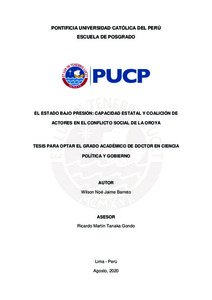| dc.contributor.advisor | Tanaka Gondo, Ricardo Martín | |
| dc.contributor.author | Jaime Barreto, Wilson Noé | |
| dc.date.accessioned | 2020-12-02T21:13:41Z | |
| dc.date.available | 2020-12-02T21:13:41Z | |
| dc.date.created | 2020-08 | |
| dc.date.issued | 2020-12-02 | |
| dc.identifier.uri | http://hdl.handle.net/20.500.12404/17616 | |
| dc.description.abstract | Las operaciones del Complejo Metalúrgico de La Oroya (CMLO) generan
emisiones y efluentes que contaminan el medio ambiente de la ciudad, para resolver
este problema y lograr los Estándares de Calidad Ambiental (ECA) el Estado, en
cumplimiento de su función reguladora, exigió en 1997 a la empresa Doe Run Perú,
propietaria del CMLO, la ejecución de un Programa de Adecuación y Manejo Ambiental
(PAMA) en el plazo de diez años; sin embargo, la empresa incumplió el plazo y solicitó
su extensión en dos ocasiones originando un conflicto social muy complejo.
A través de una descripción y análisis del conflicto, esta tesis demuestra que los
determinantes de la actuación del Estado frente a este problema son los siguientes:
Primero, una falta de capacidad que nos muestra a un Estado débil sin autonomía
para diseñar sus políticas y sin efectividad para implementarlas. Segundo, la presión
que han ejercido los actores sociales (pobladores y trabajadores) que formaron una
coalición para apoyar a la empresa y presionar al Estado a través de acciones de
movilización. Y, tercero, una decisión intencional del propio Estado de no actuar ya sea
tolerando el incumplimiento de las normas ambientales por cálculo político, ignorando
el problema por falta de interés o, simplemente, posponiendo una solución definitiva
para evitar los costos de exigir el cumplimiento de las normas.
Por otro lado, los hallazgos nos muestran que los factores que explican la
coalición entre pobladores y trabajadores son sus intereses económicos, la dependencia
económica estructural de la ciudad de las operaciones del CMLO, una actitud pasiva
frente a la contaminación ambiental, una mayor valoración al trabajo que a la salud y
un conjunto de factores sociales y culturales.
Los resultados de esta investigación contribuirán a un mejor conocimiento sobre
el funcionamiento del Estado en el Perú así como de los factores determinantes de la
calidad de sus respuestas a los problemas del país. | es_ES |
| dc.description.abstract | The operations of the La Oroya Metallurgical Complex (CMLO) generate emissions
and effluents that pollute the city's environment, to solve this problem and achieve the
Environmental Quality Standards (EQS) the State, in compliance with its regulatory
function, demanded in 1997 to the company Doe Run Peru, owner of the CMLO, the
execution of an Environmental Adaptation and Management Program (PAMA) within
ten years; however, the company failed to meet the deadline and requested its extension
on two occasions, causing a very complex social conflict.
Through a description and analysis of the conflict, this thesis shows that the
determinants of the State's action against this problem are the following: First, a lack of
capacity that shows us a weak State without autonomy to design its policies and
without effectiveness to implement them. Second, the pressure exerted by social actors
(residents and workers) who formed a coalition to support the company and put
pressure on the State through mobilization actions. And third, an intentional decision
by the State itself not to act, either by tolerating noncompliance with environmental
regulations by political calculation, ignoring the problem due to lack of interest, or
simply postponing a definitive solution to avoid the costs of demanding compliance
with the rules.
On the other hand, the findings show us that the factors that explain the coalition
between residents and workers are their economic interests, the city's structural
economic dependence on CMLO operations, a passive attitude towards environmental
contamination, a higher valuation to the work than to health and a series of social and
cultural factors.
The results of this research will contribute to a better understanding of the
functioning of the State in Peru as well as of the determinants factors of the quality of
its responses to the country's problems. | es_ES |
| dc.language.iso | spa | es_ES |
| dc.publisher | Pontificia Universidad Católica del Perú | es_ES |
| dc.rights | info:eu-repo/semantics/openAccess | es_ES |
| dc.rights.uri | http://creativecommons.org/licenses/by-nc-sa/2.5/pe/ | * |
| dc.subject | Industria minera--Aspectos ambientales--Perú--La Oroya (Junín : Distrito) | es_ES |
| dc.subject | Conflicto social--Perú--La Oroya (Junín : Distrito) | es_ES |
| dc.subject | Política ambiental--Perú--La Oroya (Junín : Distrito) | es_ES |
| dc.title | El Estado bajo presión: capacidad estatal y coalición de actores en el conflicto social de La Oroya | es_ES |
| dc.type | info:eu-repo/semantics/doctoralThesis | es_ES |
| thesis.degree.name | Doctor en Ciencia Política y Gobierno | es_ES |
| thesis.degree.level | Doctorado | es_ES |
| thesis.degree.grantor | Pontificia Universidad Católica del Perú. Escuela de Posgrado | es_ES |
| thesis.degree.discipline | Ciencia Política y Gobierno | es_ES |
| renati.advisor.dni | 06408442 | |
| renati.advisor.orcid | https://orcid.org/0000-0001-6640-1518 | es_ES |
| renati.author.dni | 10285735 | |
| renati.discipline | 312018 | es_ES |
| renati.juror | Henriquez Ayin, Narda Zoila | |
| renati.juror | Tanaka Gondo, Ricardo Martin | |
| renati.juror | Dargent Bocanegra, Eduardo Hernando | |
| renati.juror | Maldonado Nicho, Arturo | |
| renati.juror | Sanborn , Cynthia Ann | |
| renati.level | https://purl.org/pe-repo/renati/level#doctor | es_ES |
| renati.type | http://purl.org/pe-repo/renati/type#tesis | es_ES |
| dc.publisher.country | PE | |
| dc.subject.ocde | https://purl.org/pe-repo/ocde/ford#5.06.01 | es_ES |






